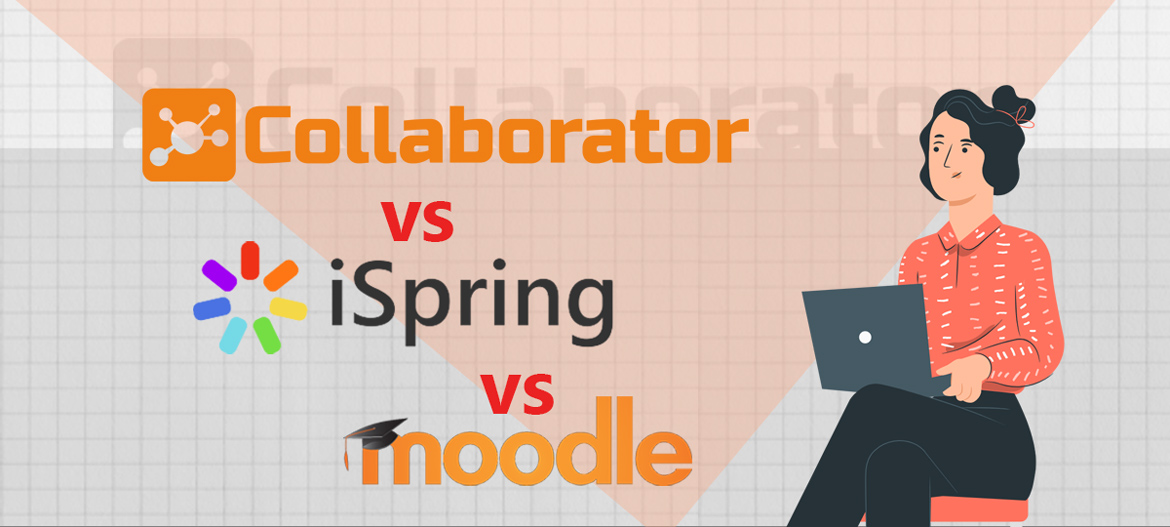
LMS Collaborator vs Moodle vs iSpring: a comparison based on materials from an e-learning expert
Learning management systems (LMS) allow you to remotely manage the training of each employee: assign tasks, track results, and monitor progress. With the help of LMS you can organize the learning process “from scratch” and automate many processes, such as product training, onboarding and certification.
Today there are many LMSs, which have their own unique interface and functionality, allowing to bring distance learning to a new level. Based on materials from Svitlana Ponomarenko we have prepared a comparison of three LMS-systems: LMS Collaborator, Moodle and iSpring.
 Svitlana Ponomarenko – head of “e-learning Studio” and organizer of ELForum Kazakhstan conferences.
Svitlana Ponomarenko – head of “e-learning Studio” and organizer of ELForum Kazakhstan conferences.
The comparison is highly informative, so we’ve divided it into two parts. In this article, we’ll talk about the features of each system’s portals, creating and assigning learning tasks, running quizzes, organizing webinars, learning paths, and collecting analytics.
In the second part we will talk in more detail about gamification tools, features of communication with users, creating a knowledge base, conducting surveys, and a list of available integrations. Also in this part there will be conclusions from the e-learning expert Svitlana Ponomarenko.
Read more: LMS Collaborator vs Moodle vs iSpring: a comparison of materials from an e-learning expert (part 2)
Features
LMS Collaborator
![]() A corporate distance learning system. There are tools for organizing assessments, management by goals, creating organizational structures and many channels for communication with users. Built on REST API technology, which allows it to integrate easily with any IT systems. Works effectively on all modern devices and browsers. More than 12 updates with improvements and new features are released per year. New versions are developed based on the analysis of customer requests and tasks.
A corporate distance learning system. There are tools for organizing assessments, management by goals, creating organizational structures and many channels for communication with users. Built on REST API technology, which allows it to integrate easily with any IT systems. Works effectively on all modern devices and browsers. More than 12 updates with improvements and new features are released per year. New versions are developed based on the analysis of customer requests and tasks.
LMS Collaborator team develops a community of corporate training professionals and conducts mentoring sessions as part of the practical e-learning event El`Lab.
Information channels:
YouTube, Facebook, Instagram, Blog
Moodle
 The most famous and popular e-learning platform in educational institutions, actively used in universities. Moodle platform is free, open-source, developed through plug-ins. It is difficult to determine which plugins from the huge number of ready-made best fit the task of training, so many people prefer to write their own (PHP language).
The most famous and popular e-learning platform in educational institutions, actively used in universities. Moodle platform is free, open-source, developed through plug-ins. It is difficult to determine which plugins from the huge number of ready-made best fit the task of training, so many people prefer to write their own (PHP language).
Free, official, version-checked plugins can be downloaded here.
There are also paid plugins, on average $50-100 per feature. They are sold on developer sites such as in this example. There are many companies that do the necessary fine-tuning and customization of Moodle.
The interface of Moodle was usually overloaded by the logic of the system, but in April 2022 Moodle received an update 4.0, where the interface problem was largely solved.
iSpring
 It has two products: the distance learning system – iSpring Learn and the course builder – iSpring Suite. iSpring Suite is integrated with Learn, so after creating a course it can be immediately published on the portal, it is also possible to work together on the course.
It has two products: the distance learning system – iSpring Learn and the course builder – iSpring Suite. iSpring Suite is integrated with Learn, so after creating a course it can be immediately published on the portal, it is also possible to work together on the course.
iSpring actively develops its community: they regularly run a blog, hold face-to-face conferences, free broadcasts on YouTube and methodological webinars. iSpring has also created its own online academy for anyone who wants to learn course development and instructional design.
Portal
LMS Collaborator
The main page of the portal contains information blocks that can be customized by the Administrator – “My tasks”, “News”, “Notifications”, “Birthdays”, etc.

Menus and commands are grouped by process – Learning, Development, Assessment, Information, User Management.

The system interface is unified for use and administration. For example, in the Supervisor role you can learn and manage the learning of others – view reports, assign tasks, etc.
You can set up a portal guide for the learner.

If you want to try LMS Collaborator, we will be happy to show you all the possibilities.
Moodle
The design of the portal depends on the installed plugins. The main page of the new Moodle version contains 3 tabs – “Home”, “Dashboard” and “My courses”. After entering a login and password, the student sees the Dashboard on the home page, which displays upcoming events (events, deadlines for assignments) and the calendar.

Home Tab – Goes to the login screen. My Courses – Goes to your assigned courses.
In the admin panel, non-core functions are collapsed into the More menu.

You can set up a portal guide for the learner.

Since Moodle is designed to create long courses, on the left side of the implemented navigation panel with a mark passed activities.

iSpring
There is no news feed on the portal. The main menu consists of blocks – “My courses”, “Events”, “Catalog”, “Knowledge Base”. For managers, the “My Team” tab is also available.
Learning and content
LMS Collaborator
In LMS Collaborator educational information is presented in the form of resources – images, videos, text files of different formats, pages, etc. You can import ready-made resources or create new ones. In addition to resources for viewing, there is interactive content: quizzes, surveys, checklists, workshops, webinars, meetups. All of this can be combined into simple courses or complex training programs. Learning content is delivered to users through tasks that are created from the resources.

A separate report is available for each type of task.
Moodle
The creation of any learning material in Moodle begins with the creation of a course. A course is the main unit of content. To create a separate test, you first need to create a course and add a test to it as an educational element. In order to use learning content simultaneously in multiple courses, you need to install a separate plugin – Subcourse.

The type of course structure also depends entirely on the plugins installed. Integration through a plugin with H5P allows you to put a variety of interactivity into the course for presenting information and for self-checking.
iSpring
Tutorials in iSpring are individual files, pages, scorm files. They can be grouped into folders by topic or by unit. When creating a course, you can use materials added to the system or create new ones. Course development and creation of materials is usually done within the same project. It is possible to share project editing with all members of the development team.
The portal has a built-in longreads (html pages) editor – a simplified articulate rise that allows you to use header templates, edit text, insert quotes and pictures.
Learning assignment
LMS Collaborator
Tasks in LMS Collaborator can be assigned to users manually or automatically using automation rules.

Users can also assign their own tasks from the Catalog.

If you want to assign tasks to a specific group of users, you can quickly filter them by attributes, organizational structure or tags.
Moodle
There is no way to filter users in Moodle. Due to the lack of organizational structure, tasks can only be assigned manually.
iSpring
Training courses can be simultaneously assigned to users of mixed groups, such as different departments. For this purpose, smart groups are created with automatic selection of users from different groups, departments, with different positions.

Testing
LMS Collaborator
The built-in quiz editor allows you to create 7 types of questions. These include sequencing, classification, matching, and open-answer questions. You can also import prepared questions from a text file or copy from other quizzes. At the end of the test the statistics of the answers for each question is collected, which allows you to analyze its quality.

You can create a complex quiz from several quizzes, which allows you to check the knowledge of the learner on several topics at the same time. At the end of the quiz, a summary result is displayed for all topics, as well as separately for each quiz taken.
Moodle
Moodle has a built-in quiz editor. Creating a quiz is done in three steps:
- Creating a course.
- Creating a quiz and configuring all its parameters.
- Creation of quiz questions and setting their parameters.
You can import ready-made questions from a Word document. In addition, all created questions are automatically placed in the question bank, and when you create a new quiz, you can add questions from the bank.
iSpring
The latest system update has a built-in quiz editor that is created as part of the course. The editor supports the creation of 3 types of questions: one answer, multiple answers, and a short answer. You can also customize the design: set accent colors, select fonts. If desired, you can open access for collaborative work on the quiz.
Webinars
LMS Collaborator
LMS Collaborator provides integration with several services for webinars: BigBlueButton, eTutorium, MS Teams.
Webinars in LMS Collaborator are presented in the format of training tasks. Creating and assigning users to a webinar is similar to other types of assignments.
Moodle
The basic version of Moodle supports integration with the BigBlueButton service. You can also set up integrations with Zoom and MS Teams via plugin installation.
iSpring
iSpring provides integration with two webinar services: Zoom and MS Team.
Adaptive learning paths
LMS Collaborator
Learning paths in LMS Collaborator are a set of learning tasks combined into one curriculum, in which the rules of automatic assignment of tasks based on the results of previous ones work. Learning paths editor allows you to set a branched path of learning tasks. You can also customize the logic of assigning tasks in the path by making pauses between tasks or closing access after a set period of time.

Moreover, after completing a path, you can automatically assign the user the next one and split the training by specifying the direction to different paths, which will be assigned according to the results of the tasks.
Moodle
In Moodle there is no way to automatically assign a course based on the results of the previous one. But within a course it is possible to set a condition under which successful completion of one learning element allows access to another.
It is possible to set up training of several groups within the same course in different paths. To do this, a course is created as a sequence of learning elements and, when assigning it to different groups of users, the conditions for the elements are prescribed. For example, one group will only have access to asynchronous online activities that are opened sequentially on condition of successful completion, another group – face-to-face sessions with a teacher, workshops and video lessons, the third with demo access – only the first section is open for 2 weeks.
iSpring
In iSpring, learning paths are created by combining courses into one curriculum. You can open access to all courses of the pathway at once or set the order of assignment: by date or sequentially, after passing the previous course. You can also set the required passing score that you need to get in order to access the next course.
Reports
LMS Collaborator
Different types of reports are available in the portal: tabular reports on all learning activities, a summary report on training, administrative reports on system actions, using the Knowledge Base, sending messages to users, import protocols, etc. All reports are exported in MS Excel format and accessible via API. This allows you to create reports of any complexity and connect analytics systems including Google Data Studio, Power BI and others.

The reports have filters that allow you to view and analyze the data you need. Also managers can set up access to reports by their subordinates.

Furthermore, LMS Collaborator has a toolkit for creating individual reports for client tasks, which are set up by Technical Support.
Moodle
The format of the reports depends on the installed plugins. To create reports, you need to load plugins that will determine what data you need to get and how to display them. It is not possible for a manager to configure reports to be sent to subordinates.
iSpring
There are 4 types of reports available in iSpring: by learners, courses, events and additional reports on awards. The system also collects data for managers on the training of their subordinates – Dashboard Manager.

All reports can be exported in csv and xlsx formats, or you can set up automatic email reports on a schedule – for example, a report on training employees for their manager.

We have reached the end of the first part of our review. Next week we will publish the second part of our material, in which there will be a review of gamification tools, features of communication with users, creating a knowledge base, conducting surveys and votes, a list of available integrations, as well as conclusions from e-learning expert Svitlana Ponomarenko.



































